Health Promotion Report: Diabetes in Hong Kong - Program Details
VerifiedAdded on 2022/08/14
|22
|5389
|26
Report
AI Summary
This report addresses the critical issue of rising diabetes rates in Hong Kong, specifically focusing on Type 2 diabetes. It begins with an introduction to health promotion and its importance in preventing diseases and improving quality of life. The report then highlights the health problem of diabetes in Hong Kong, discussing its different types, prevalence, and socio-economic determinants. It emphasizes the use of the Reference Framework for Diabetes, outlining its components and recommendations for lifestyle adoption, early identification, and clinical care. The report includes a health need assessment, targeting adults with newly diagnosed diabetes, and provides a detailed program aim and objectives to combat the issue. Strategies include the Health Belief Model and health communication strategies, along with proposed health promotion activities and evaluation methods. The report concludes with a comprehensive overview of diabetes in Hong Kong, offering a valuable resource for students studying health promotion.
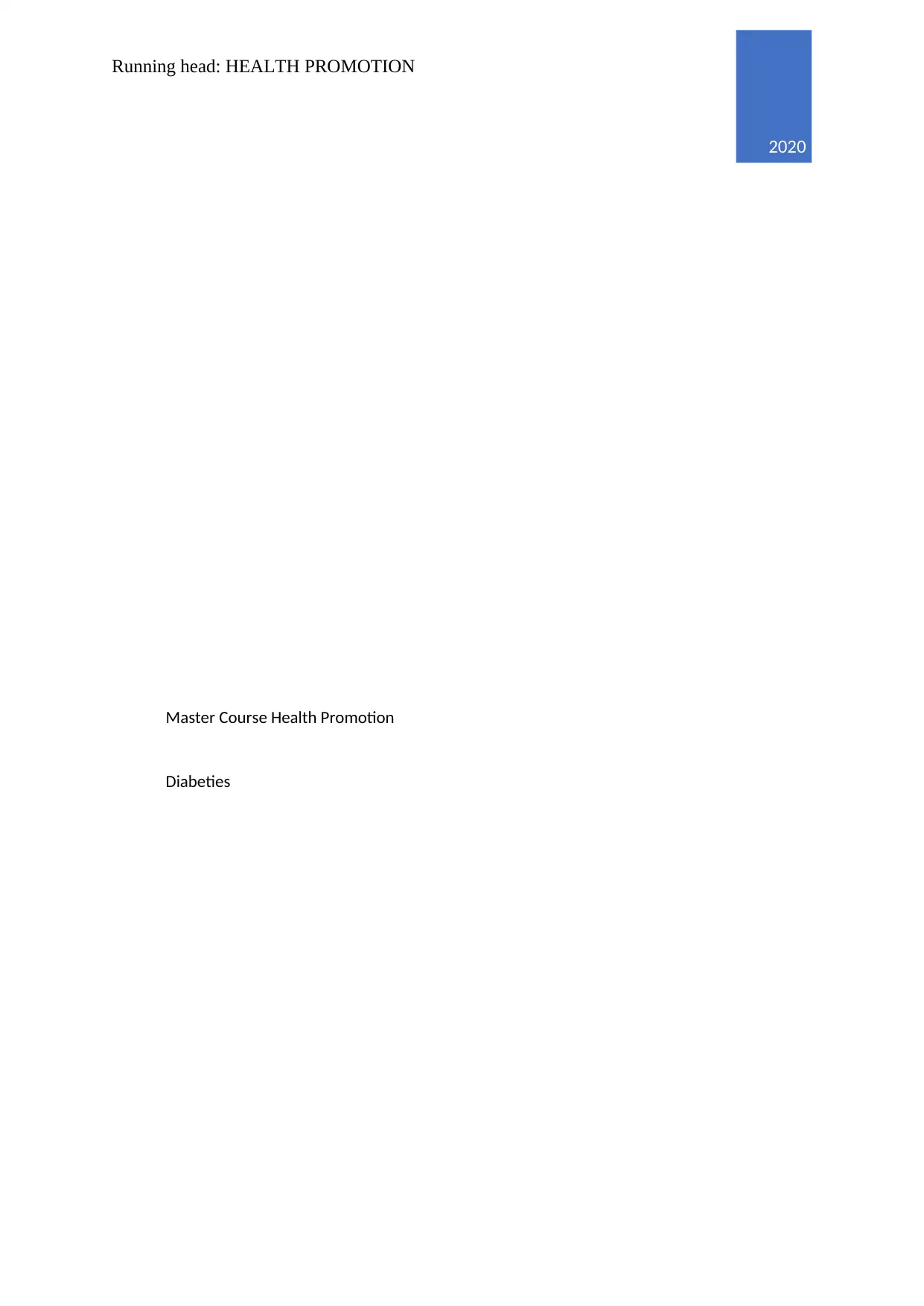
Running head: HEALTH PROMOTION
2020
Master Course Health Promotion
Diabeties
2020
Master Course Health Promotion
Diabeties
Paraphrase This Document
Need a fresh take? Get an instant paraphrase of this document with our AI Paraphraser
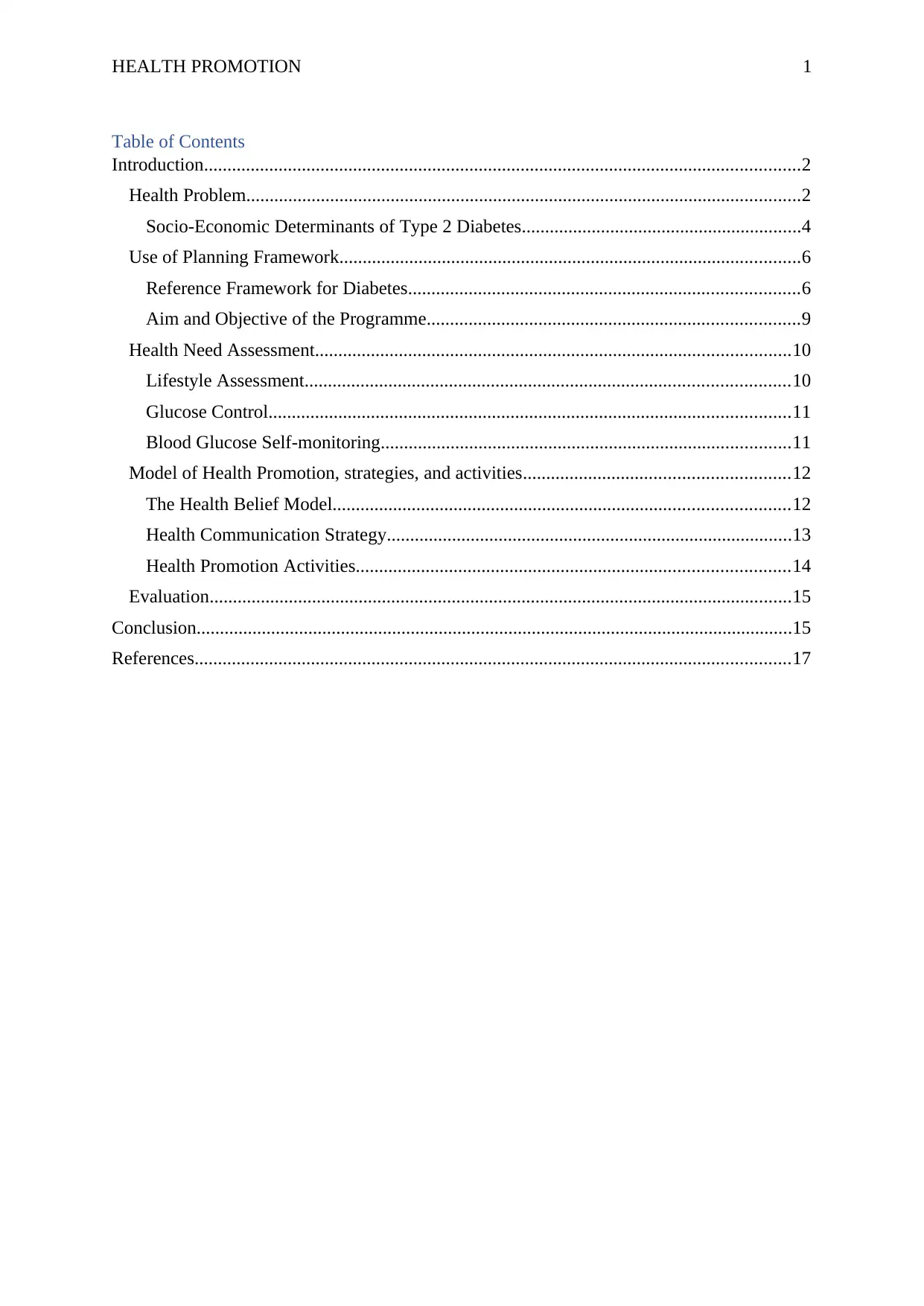
HEALTH PROMOTION 1
Table of Contents
Introduction................................................................................................................................2
Health Problem.......................................................................................................................2
Socio-Economic Determinants of Type 2 Diabetes............................................................4
Use of Planning Framework...................................................................................................6
Reference Framework for Diabetes....................................................................................6
Aim and Objective of the Programme................................................................................9
Health Need Assessment......................................................................................................10
Lifestyle Assessment........................................................................................................10
Glucose Control................................................................................................................11
Blood Glucose Self-monitoring........................................................................................11
Model of Health Promotion, strategies, and activities.........................................................12
The Health Belief Model..................................................................................................12
Health Communication Strategy.......................................................................................13
Health Promotion Activities.............................................................................................14
Evaluation.............................................................................................................................15
Conclusion................................................................................................................................15
References................................................................................................................................17
Table of Contents
Introduction................................................................................................................................2
Health Problem.......................................................................................................................2
Socio-Economic Determinants of Type 2 Diabetes............................................................4
Use of Planning Framework...................................................................................................6
Reference Framework for Diabetes....................................................................................6
Aim and Objective of the Programme................................................................................9
Health Need Assessment......................................................................................................10
Lifestyle Assessment........................................................................................................10
Glucose Control................................................................................................................11
Blood Glucose Self-monitoring........................................................................................11
Model of Health Promotion, strategies, and activities.........................................................12
The Health Belief Model..................................................................................................12
Health Communication Strategy.......................................................................................13
Health Promotion Activities.............................................................................................14
Evaluation.............................................................................................................................15
Conclusion................................................................................................................................15
References................................................................................................................................17
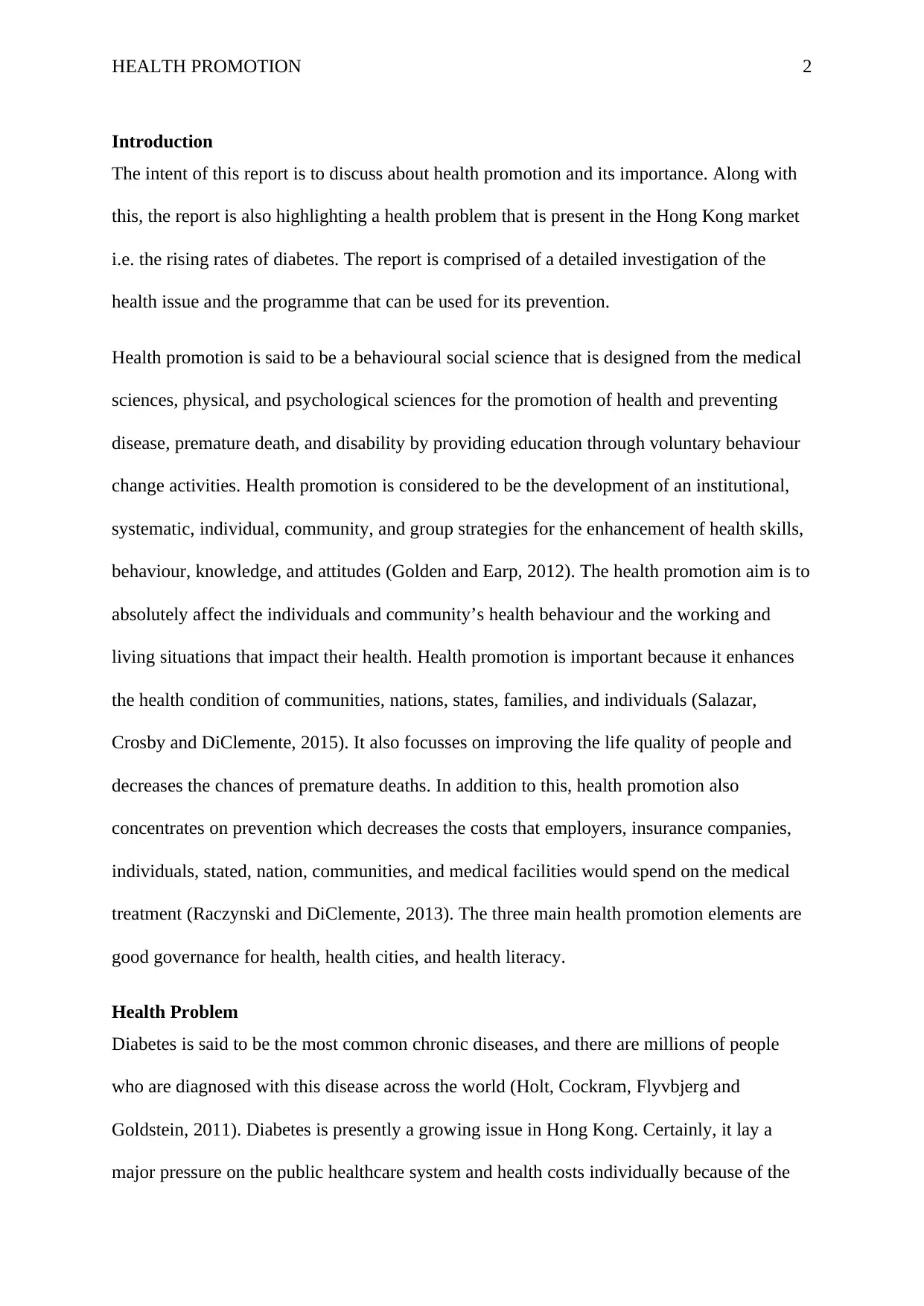
HEALTH PROMOTION 2
Introduction
The intent of this report is to discuss about health promotion and its importance. Along with
this, the report is also highlighting a health problem that is present in the Hong Kong market
i.e. the rising rates of diabetes. The report is comprised of a detailed investigation of the
health issue and the programme that can be used for its prevention.
Health promotion is said to be a behavioural social science that is designed from the medical
sciences, physical, and psychological sciences for the promotion of health and preventing
disease, premature death, and disability by providing education through voluntary behaviour
change activities. Health promotion is considered to be the development of an institutional,
systematic, individual, community, and group strategies for the enhancement of health skills,
behaviour, knowledge, and attitudes (Golden and Earp, 2012). The health promotion aim is to
absolutely affect the individuals and community’s health behaviour and the working and
living situations that impact their health. Health promotion is important because it enhances
the health condition of communities, nations, states, families, and individuals (Salazar,
Crosby and DiClemente, 2015). It also focusses on improving the life quality of people and
decreases the chances of premature deaths. In addition to this, health promotion also
concentrates on prevention which decreases the costs that employers, insurance companies,
individuals, stated, nation, communities, and medical facilities would spend on the medical
treatment (Raczynski and DiClemente, 2013). The three main health promotion elements are
good governance for health, health cities, and health literacy.
Health Problem
Diabetes is said to be the most common chronic diseases, and there are millions of people
who are diagnosed with this disease across the world (Holt, Cockram, Flyvbjerg and
Goldstein, 2011). Diabetes is presently a growing issue in Hong Kong. Certainly, it lay a
major pressure on the public healthcare system and health costs individually because of the
Introduction
The intent of this report is to discuss about health promotion and its importance. Along with
this, the report is also highlighting a health problem that is present in the Hong Kong market
i.e. the rising rates of diabetes. The report is comprised of a detailed investigation of the
health issue and the programme that can be used for its prevention.
Health promotion is said to be a behavioural social science that is designed from the medical
sciences, physical, and psychological sciences for the promotion of health and preventing
disease, premature death, and disability by providing education through voluntary behaviour
change activities. Health promotion is considered to be the development of an institutional,
systematic, individual, community, and group strategies for the enhancement of health skills,
behaviour, knowledge, and attitudes (Golden and Earp, 2012). The health promotion aim is to
absolutely affect the individuals and community’s health behaviour and the working and
living situations that impact their health. Health promotion is important because it enhances
the health condition of communities, nations, states, families, and individuals (Salazar,
Crosby and DiClemente, 2015). It also focusses on improving the life quality of people and
decreases the chances of premature deaths. In addition to this, health promotion also
concentrates on prevention which decreases the costs that employers, insurance companies,
individuals, stated, nation, communities, and medical facilities would spend on the medical
treatment (Raczynski and DiClemente, 2013). The three main health promotion elements are
good governance for health, health cities, and health literacy.
Health Problem
Diabetes is said to be the most common chronic diseases, and there are millions of people
who are diagnosed with this disease across the world (Holt, Cockram, Flyvbjerg and
Goldstein, 2011). Diabetes is presently a growing issue in Hong Kong. Certainly, it lay a
major pressure on the public healthcare system and health costs individually because of the
⊘ This is a preview!⊘
Do you want full access?
Subscribe today to unlock all pages.

Trusted by 1+ million students worldwide
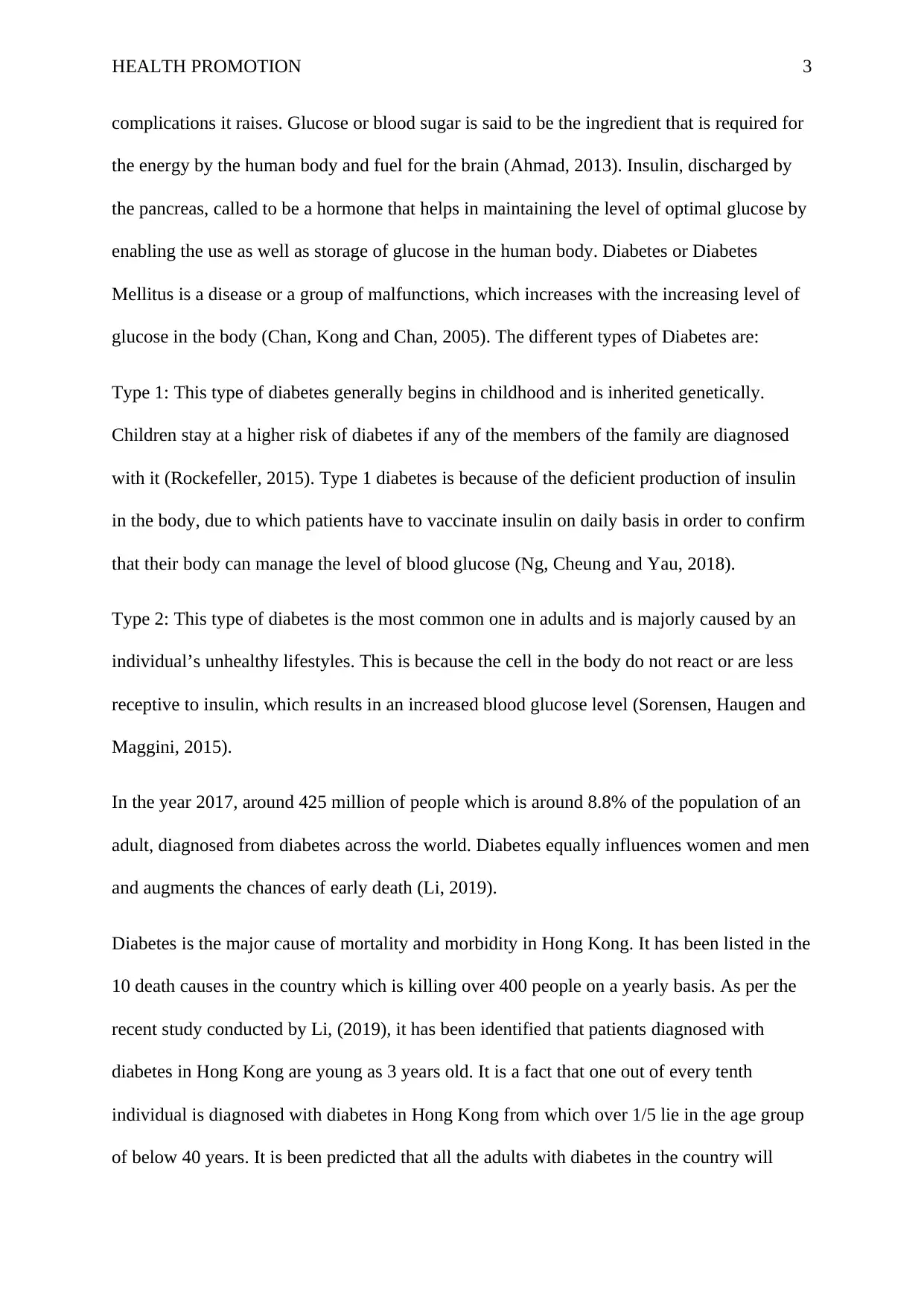
HEALTH PROMOTION 3
complications it raises. Glucose or blood sugar is said to be the ingredient that is required for
the energy by the human body and fuel for the brain (Ahmad, 2013). Insulin, discharged by
the pancreas, called to be a hormone that helps in maintaining the level of optimal glucose by
enabling the use as well as storage of glucose in the human body. Diabetes or Diabetes
Mellitus is a disease or a group of malfunctions, which increases with the increasing level of
glucose in the body (Chan, Kong and Chan, 2005). The different types of Diabetes are:
Type 1: This type of diabetes generally begins in childhood and is inherited genetically.
Children stay at a higher risk of diabetes if any of the members of the family are diagnosed
with it (Rockefeller, 2015). Type 1 diabetes is because of the deficient production of insulin
in the body, due to which patients have to vaccinate insulin on daily basis in order to confirm
that their body can manage the level of blood glucose (Ng, Cheung and Yau, 2018).
Type 2: This type of diabetes is the most common one in adults and is majorly caused by an
individual’s unhealthy lifestyles. This is because the cell in the body do not react or are less
receptive to insulin, which results in an increased blood glucose level (Sorensen, Haugen and
Maggini, 2015).
In the year 2017, around 425 million of people which is around 8.8% of the population of an
adult, diagnosed from diabetes across the world. Diabetes equally influences women and men
and augments the chances of early death (Li, 2019).
Diabetes is the major cause of mortality and morbidity in Hong Kong. It has been listed in the
10 death causes in the country which is killing over 400 people on a yearly basis. As per the
recent study conducted by Li, (2019), it has been identified that patients diagnosed with
diabetes in Hong Kong are young as 3 years old. It is a fact that one out of every tenth
individual is diagnosed with diabetes in Hong Kong from which over 1/5 lie in the age group
of below 40 years. It is been predicted that all the adults with diabetes in the country will
complications it raises. Glucose or blood sugar is said to be the ingredient that is required for
the energy by the human body and fuel for the brain (Ahmad, 2013). Insulin, discharged by
the pancreas, called to be a hormone that helps in maintaining the level of optimal glucose by
enabling the use as well as storage of glucose in the human body. Diabetes or Diabetes
Mellitus is a disease or a group of malfunctions, which increases with the increasing level of
glucose in the body (Chan, Kong and Chan, 2005). The different types of Diabetes are:
Type 1: This type of diabetes generally begins in childhood and is inherited genetically.
Children stay at a higher risk of diabetes if any of the members of the family are diagnosed
with it (Rockefeller, 2015). Type 1 diabetes is because of the deficient production of insulin
in the body, due to which patients have to vaccinate insulin on daily basis in order to confirm
that their body can manage the level of blood glucose (Ng, Cheung and Yau, 2018).
Type 2: This type of diabetes is the most common one in adults and is majorly caused by an
individual’s unhealthy lifestyles. This is because the cell in the body do not react or are less
receptive to insulin, which results in an increased blood glucose level (Sorensen, Haugen and
Maggini, 2015).
In the year 2017, around 425 million of people which is around 8.8% of the population of an
adult, diagnosed from diabetes across the world. Diabetes equally influences women and men
and augments the chances of early death (Li, 2019).
Diabetes is the major cause of mortality and morbidity in Hong Kong. It has been listed in the
10 death causes in the country which is killing over 400 people on a yearly basis. As per the
recent study conducted by Li, (2019), it has been identified that patients diagnosed with
diabetes in Hong Kong are young as 3 years old. It is a fact that one out of every tenth
individual is diagnosed with diabetes in Hong Kong from which over 1/5 lie in the age group
of below 40 years. It is been predicted that all the adults with diabetes in the country will
Paraphrase This Document
Need a fresh take? Get an instant paraphrase of this document with our AI Paraphraser
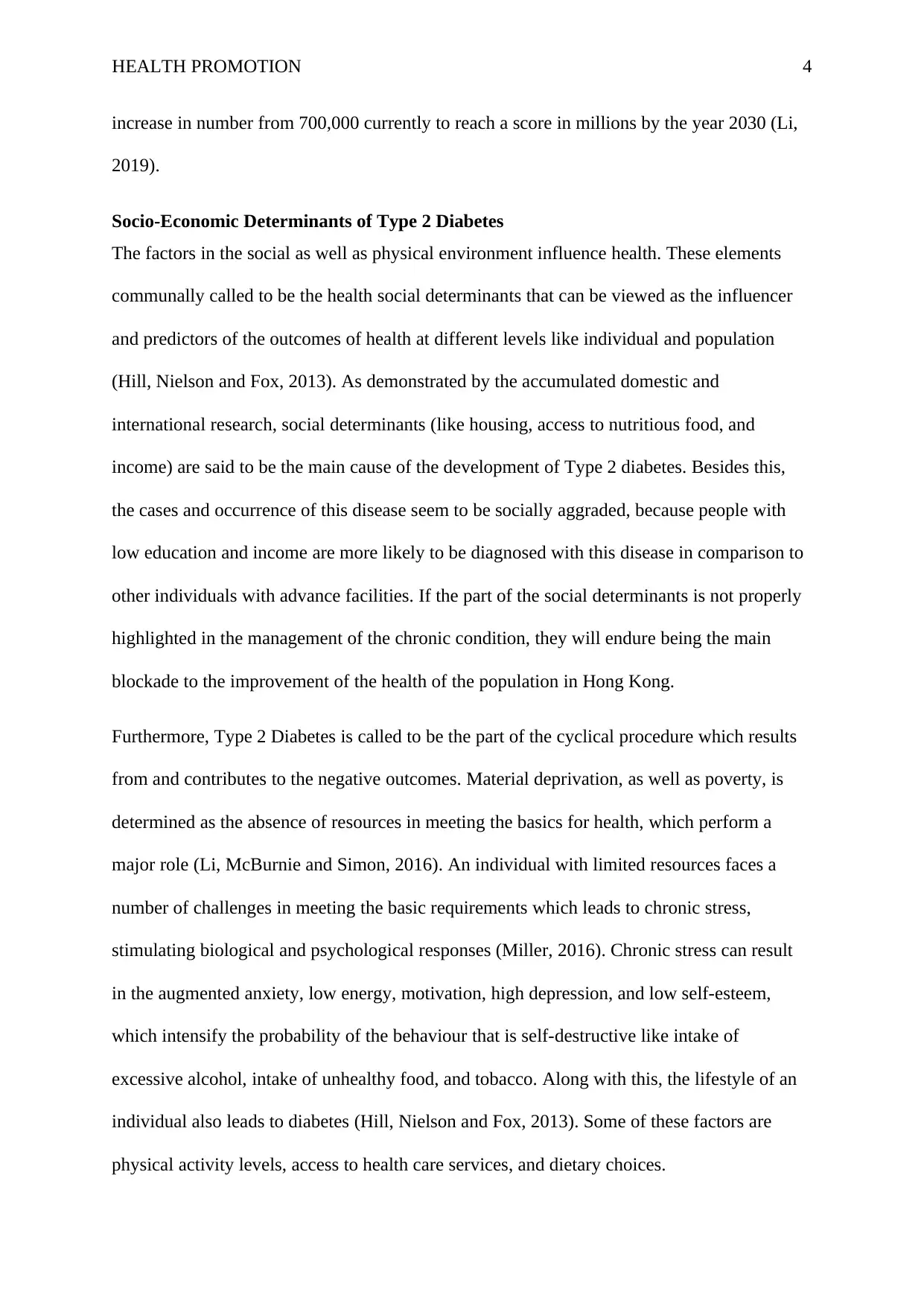
HEALTH PROMOTION 4
increase in number from 700,000 currently to reach a score in millions by the year 2030 (Li,
2019).
Socio-Economic Determinants of Type 2 Diabetes
The factors in the social as well as physical environment influence health. These elements
communally called to be the health social determinants that can be viewed as the influencer
and predictors of the outcomes of health at different levels like individual and population
(Hill, Nielson and Fox, 2013). As demonstrated by the accumulated domestic and
international research, social determinants (like housing, access to nutritious food, and
income) are said to be the main cause of the development of Type 2 diabetes. Besides this,
the cases and occurrence of this disease seem to be socially aggraded, because people with
low education and income are more likely to be diagnosed with this disease in comparison to
other individuals with advance facilities. If the part of the social determinants is not properly
highlighted in the management of the chronic condition, they will endure being the main
blockade to the improvement of the health of the population in Hong Kong.
Furthermore, Type 2 Diabetes is called to be the part of the cyclical procedure which results
from and contributes to the negative outcomes. Material deprivation, as well as poverty, is
determined as the absence of resources in meeting the basics for health, which perform a
major role (Li, McBurnie and Simon, 2016). An individual with limited resources faces a
number of challenges in meeting the basic requirements which leads to chronic stress,
stimulating biological and psychological responses (Miller, 2016). Chronic stress can result
in the augmented anxiety, low energy, motivation, high depression, and low self-esteem,
which intensify the probability of the behaviour that is self-destructive like intake of
excessive alcohol, intake of unhealthy food, and tobacco. Along with this, the lifestyle of an
individual also leads to diabetes (Hill, Nielson and Fox, 2013). Some of these factors are
physical activity levels, access to health care services, and dietary choices.
increase in number from 700,000 currently to reach a score in millions by the year 2030 (Li,
2019).
Socio-Economic Determinants of Type 2 Diabetes
The factors in the social as well as physical environment influence health. These elements
communally called to be the health social determinants that can be viewed as the influencer
and predictors of the outcomes of health at different levels like individual and population
(Hill, Nielson and Fox, 2013). As demonstrated by the accumulated domestic and
international research, social determinants (like housing, access to nutritious food, and
income) are said to be the main cause of the development of Type 2 diabetes. Besides this,
the cases and occurrence of this disease seem to be socially aggraded, because people with
low education and income are more likely to be diagnosed with this disease in comparison to
other individuals with advance facilities. If the part of the social determinants is not properly
highlighted in the management of the chronic condition, they will endure being the main
blockade to the improvement of the health of the population in Hong Kong.
Furthermore, Type 2 Diabetes is called to be the part of the cyclical procedure which results
from and contributes to the negative outcomes. Material deprivation, as well as poverty, is
determined as the absence of resources in meeting the basics for health, which perform a
major role (Li, McBurnie and Simon, 2016). An individual with limited resources faces a
number of challenges in meeting the basic requirements which leads to chronic stress,
stimulating biological and psychological responses (Miller, 2016). Chronic stress can result
in the augmented anxiety, low energy, motivation, high depression, and low self-esteem,
which intensify the probability of the behaviour that is self-destructive like intake of
excessive alcohol, intake of unhealthy food, and tobacco. Along with this, the lifestyle of an
individual also leads to diabetes (Hill, Nielson and Fox, 2013). Some of these factors are
physical activity levels, access to health care services, and dietary choices.
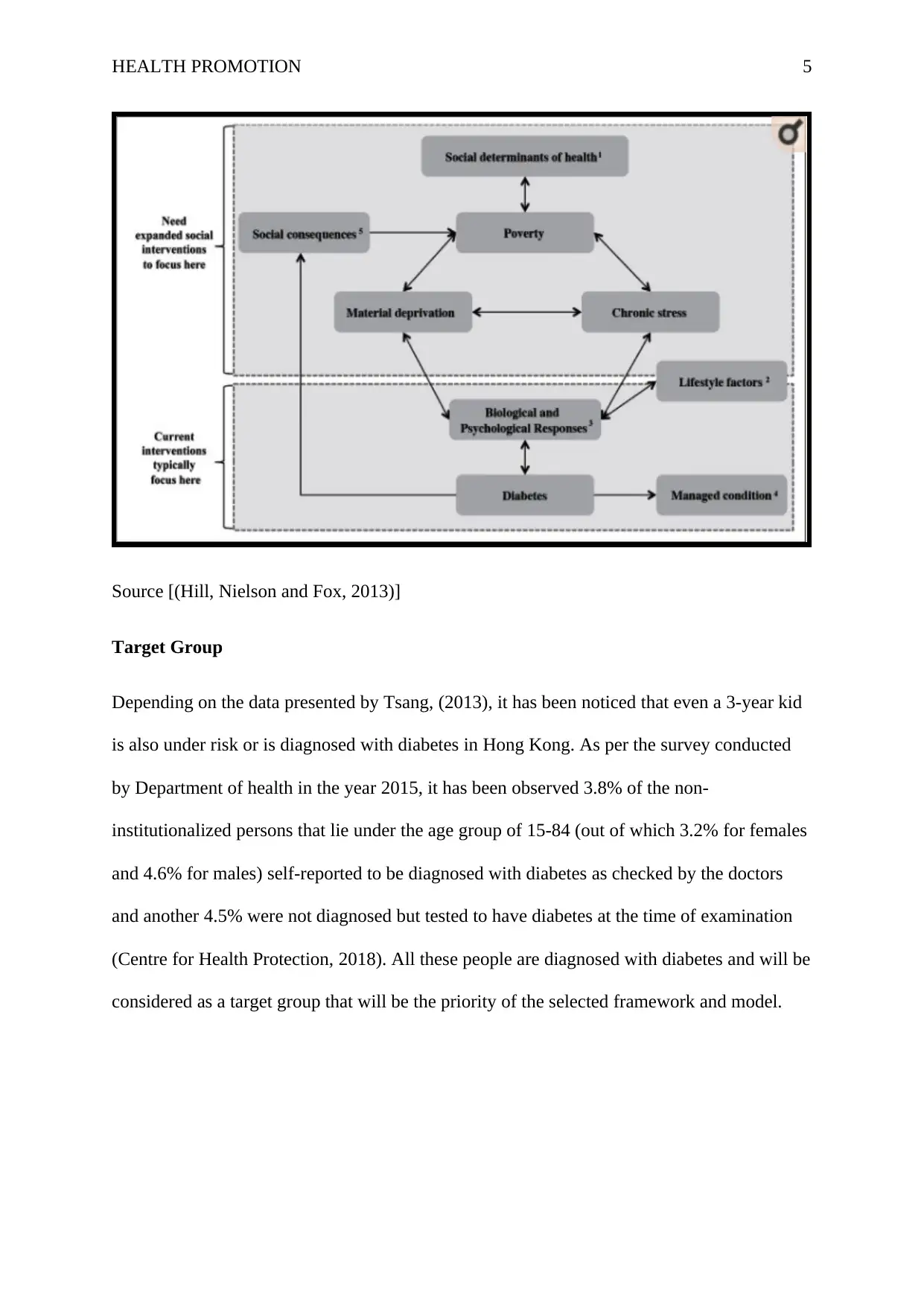
HEALTH PROMOTION 5
Source [(Hill, Nielson and Fox, 2013)]
Target Group
Depending on the data presented by Tsang, (2013), it has been noticed that even a 3-year kid
is also under risk or is diagnosed with diabetes in Hong Kong. As per the survey conducted
by Department of health in the year 2015, it has been observed 3.8% of the non-
institutionalized persons that lie under the age group of 15-84 (out of which 3.2% for females
and 4.6% for males) self-reported to be diagnosed with diabetes as checked by the doctors
and another 4.5% were not diagnosed but tested to have diabetes at the time of examination
(Centre for Health Protection, 2018). All these people are diagnosed with diabetes and will be
considered as a target group that will be the priority of the selected framework and model.
Source [(Hill, Nielson and Fox, 2013)]
Target Group
Depending on the data presented by Tsang, (2013), it has been noticed that even a 3-year kid
is also under risk or is diagnosed with diabetes in Hong Kong. As per the survey conducted
by Department of health in the year 2015, it has been observed 3.8% of the non-
institutionalized persons that lie under the age group of 15-84 (out of which 3.2% for females
and 4.6% for males) self-reported to be diagnosed with diabetes as checked by the doctors
and another 4.5% were not diagnosed but tested to have diabetes at the time of examination
(Centre for Health Protection, 2018). All these people are diagnosed with diabetes and will be
considered as a target group that will be the priority of the selected framework and model.
⊘ This is a preview!⊘
Do you want full access?
Subscribe today to unlock all pages.

Trusted by 1+ million students worldwide
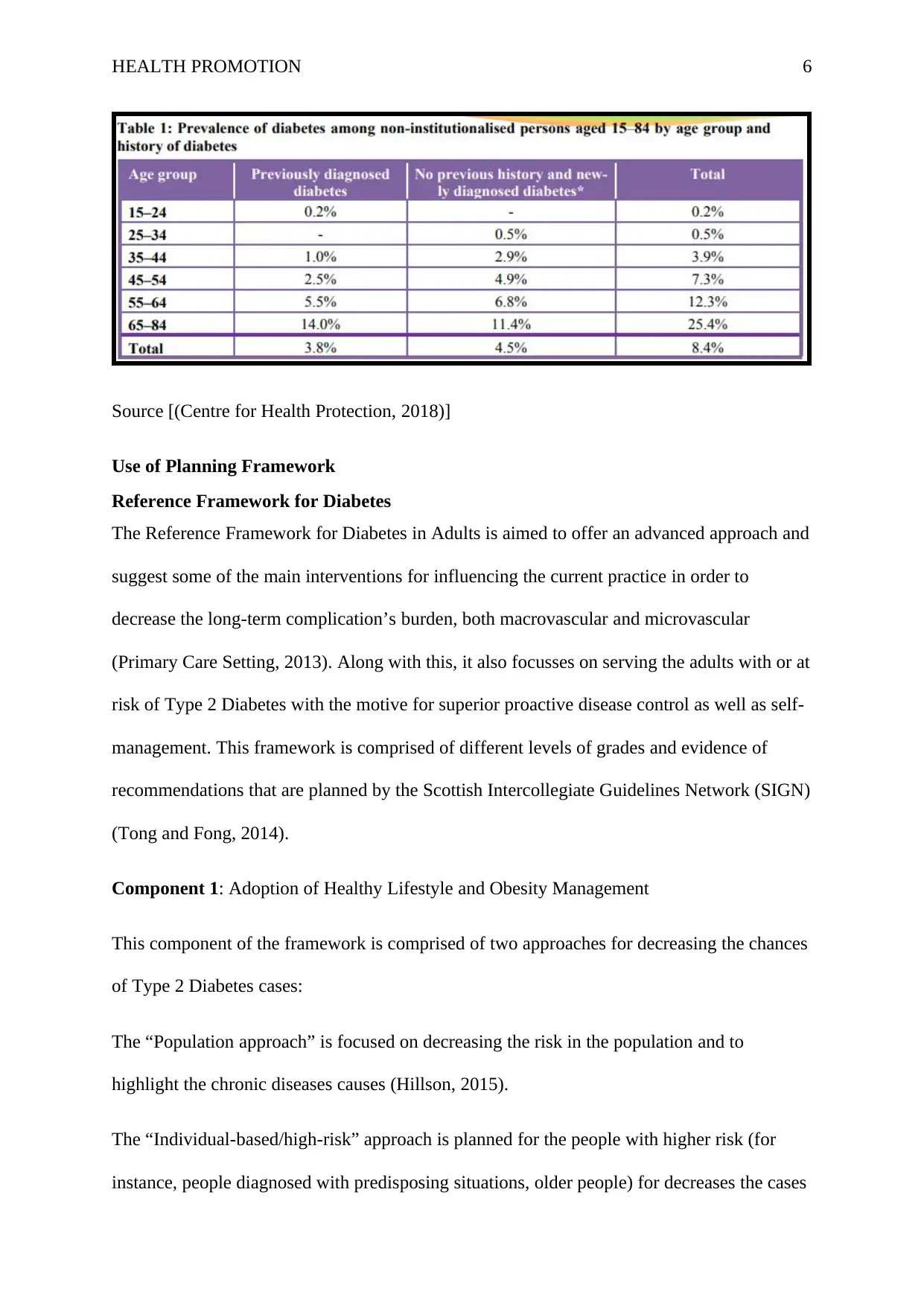
HEALTH PROMOTION 6
Source [(Centre for Health Protection, 2018)]
Use of Planning Framework
Reference Framework for Diabetes
The Reference Framework for Diabetes in Adults is aimed to offer an advanced approach and
suggest some of the main interventions for influencing the current practice in order to
decrease the long-term complication’s burden, both macrovascular and microvascular
(Primary Care Setting, 2013). Along with this, it also focusses on serving the adults with or at
risk of Type 2 Diabetes with the motive for superior proactive disease control as well as self-
management. This framework is comprised of different levels of grades and evidence of
recommendations that are planned by the Scottish Intercollegiate Guidelines Network (SIGN)
(Tong and Fong, 2014).
Component 1: Adoption of Healthy Lifestyle and Obesity Management
This component of the framework is comprised of two approaches for decreasing the chances
of Type 2 Diabetes cases:
The “Population approach” is focused on decreasing the risk in the population and to
highlight the chronic diseases causes (Hillson, 2015).
The “Individual-based/high-risk” approach is planned for the people with higher risk (for
instance, people diagnosed with predisposing situations, older people) for decreases the cases
Source [(Centre for Health Protection, 2018)]
Use of Planning Framework
Reference Framework for Diabetes
The Reference Framework for Diabetes in Adults is aimed to offer an advanced approach and
suggest some of the main interventions for influencing the current practice in order to
decrease the long-term complication’s burden, both macrovascular and microvascular
(Primary Care Setting, 2013). Along with this, it also focusses on serving the adults with or at
risk of Type 2 Diabetes with the motive for superior proactive disease control as well as self-
management. This framework is comprised of different levels of grades and evidence of
recommendations that are planned by the Scottish Intercollegiate Guidelines Network (SIGN)
(Tong and Fong, 2014).
Component 1: Adoption of Healthy Lifestyle and Obesity Management
This component of the framework is comprised of two approaches for decreasing the chances
of Type 2 Diabetes cases:
The “Population approach” is focused on decreasing the risk in the population and to
highlight the chronic diseases causes (Hillson, 2015).
The “Individual-based/high-risk” approach is planned for the people with higher risk (for
instance, people diagnosed with predisposing situations, older people) for decreases the cases
Paraphrase This Document
Need a fresh take? Get an instant paraphrase of this document with our AI Paraphraser
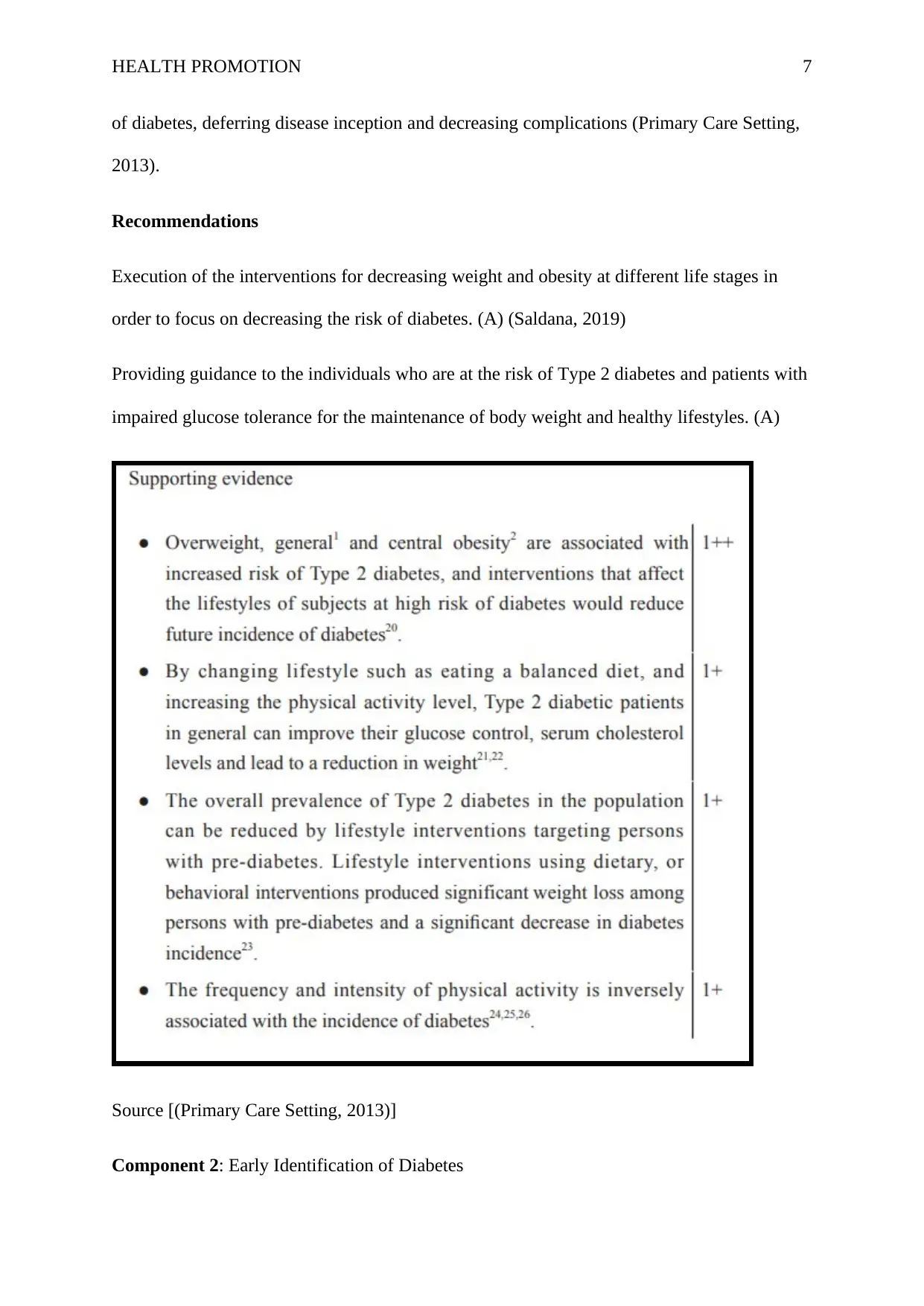
HEALTH PROMOTION 7
of diabetes, deferring disease inception and decreasing complications (Primary Care Setting,
2013).
Recommendations
Execution of the interventions for decreasing weight and obesity at different life stages in
order to focus on decreasing the risk of diabetes. (A) (Saldana, 2019)
Providing guidance to the individuals who are at the risk of Type 2 diabetes and patients with
impaired glucose tolerance for the maintenance of body weight and healthy lifestyles. (A)
Source [(Primary Care Setting, 2013)]
Component 2: Early Identification of Diabetes
of diabetes, deferring disease inception and decreasing complications (Primary Care Setting,
2013).
Recommendations
Execution of the interventions for decreasing weight and obesity at different life stages in
order to focus on decreasing the risk of diabetes. (A) (Saldana, 2019)
Providing guidance to the individuals who are at the risk of Type 2 diabetes and patients with
impaired glucose tolerance for the maintenance of body weight and healthy lifestyles. (A)
Source [(Primary Care Setting, 2013)]
Component 2: Early Identification of Diabetes
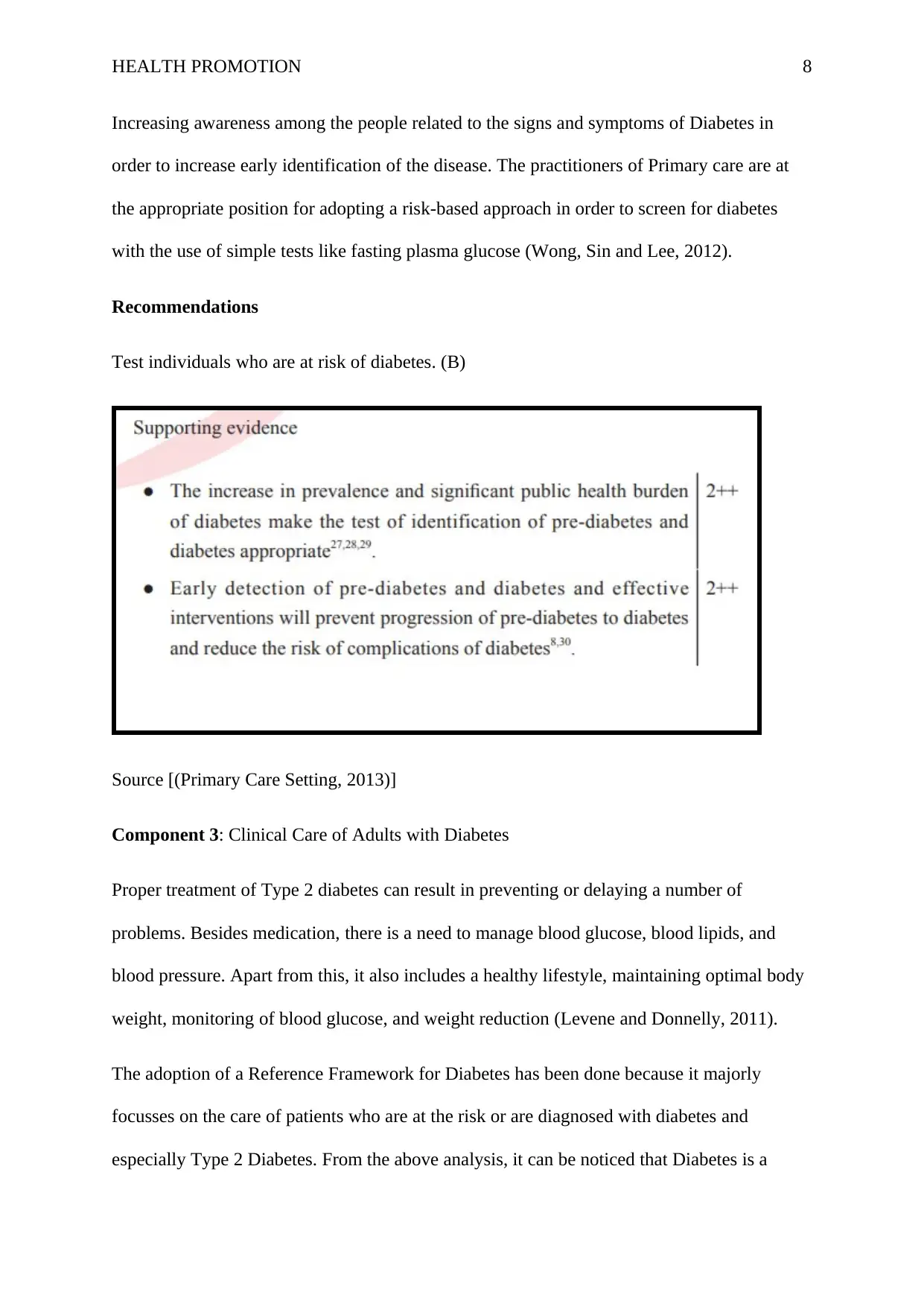
HEALTH PROMOTION 8
Increasing awareness among the people related to the signs and symptoms of Diabetes in
order to increase early identification of the disease. The practitioners of Primary care are at
the appropriate position for adopting a risk-based approach in order to screen for diabetes
with the use of simple tests like fasting plasma glucose (Wong, Sin and Lee, 2012).
Recommendations
Test individuals who are at risk of diabetes. (B)
Source [(Primary Care Setting, 2013)]
Component 3: Clinical Care of Adults with Diabetes
Proper treatment of Type 2 diabetes can result in preventing or delaying a number of
problems. Besides medication, there is a need to manage blood glucose, blood lipids, and
blood pressure. Apart from this, it also includes a healthy lifestyle, maintaining optimal body
weight, monitoring of blood glucose, and weight reduction (Levene and Donnelly, 2011).
The adoption of a Reference Framework for Diabetes has been done because it majorly
focusses on the care of patients who are at the risk or are diagnosed with diabetes and
especially Type 2 Diabetes. From the above analysis, it can be noticed that Diabetes is a
Increasing awareness among the people related to the signs and symptoms of Diabetes in
order to increase early identification of the disease. The practitioners of Primary care are at
the appropriate position for adopting a risk-based approach in order to screen for diabetes
with the use of simple tests like fasting plasma glucose (Wong, Sin and Lee, 2012).
Recommendations
Test individuals who are at risk of diabetes. (B)
Source [(Primary Care Setting, 2013)]
Component 3: Clinical Care of Adults with Diabetes
Proper treatment of Type 2 diabetes can result in preventing or delaying a number of
problems. Besides medication, there is a need to manage blood glucose, blood lipids, and
blood pressure. Apart from this, it also includes a healthy lifestyle, maintaining optimal body
weight, monitoring of blood glucose, and weight reduction (Levene and Donnelly, 2011).
The adoption of a Reference Framework for Diabetes has been done because it majorly
focusses on the care of patients who are at the risk or are diagnosed with diabetes and
especially Type 2 Diabetes. From the above analysis, it can be noticed that Diabetes is a
⊘ This is a preview!⊘
Do you want full access?
Subscribe today to unlock all pages.

Trusted by 1+ million students worldwide
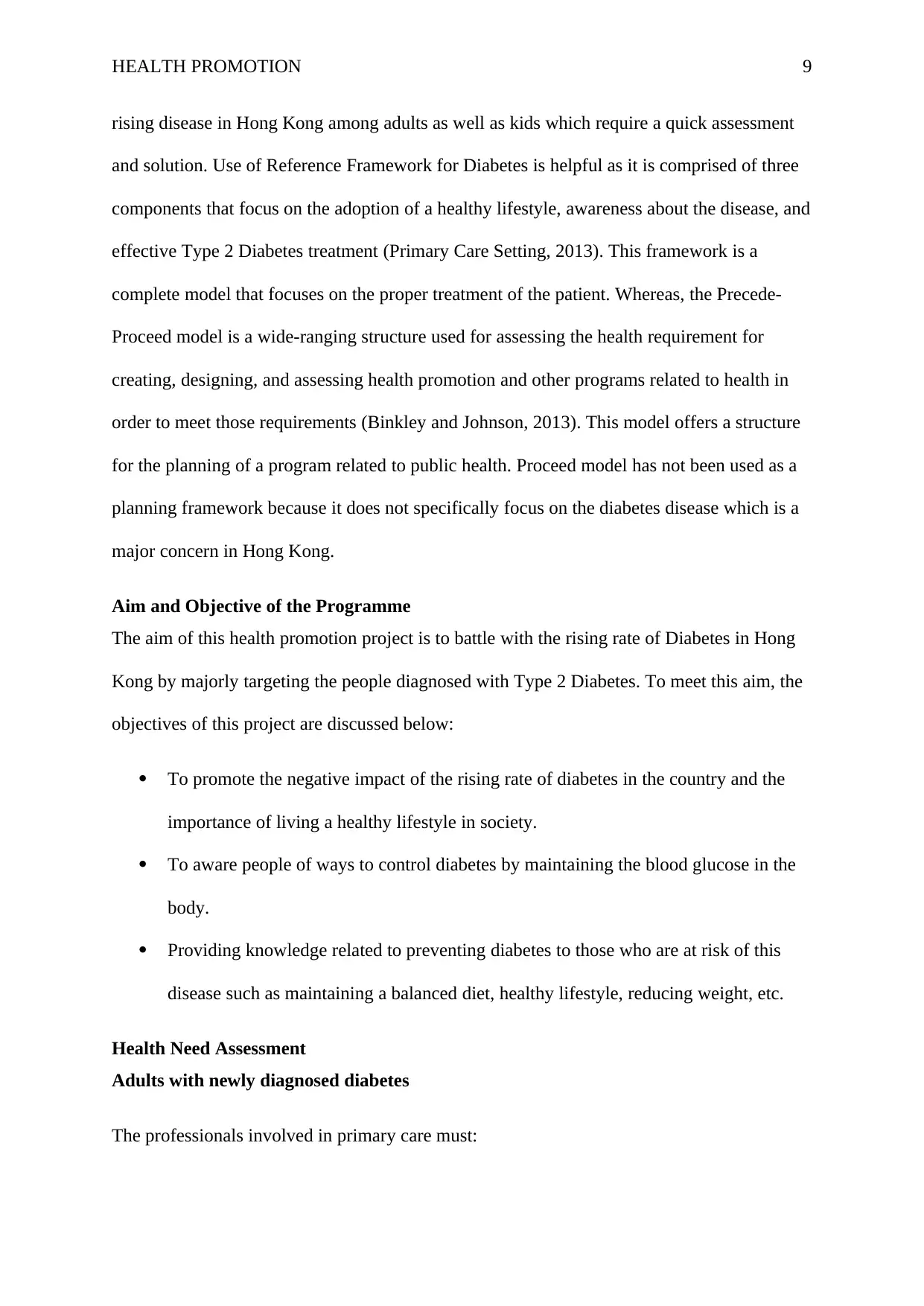
HEALTH PROMOTION 9
rising disease in Hong Kong among adults as well as kids which require a quick assessment
and solution. Use of Reference Framework for Diabetes is helpful as it is comprised of three
components that focus on the adoption of a healthy lifestyle, awareness about the disease, and
effective Type 2 Diabetes treatment (Primary Care Setting, 2013). This framework is a
complete model that focuses on the proper treatment of the patient. Whereas, the Precede-
Proceed model is a wide-ranging structure used for assessing the health requirement for
creating, designing, and assessing health promotion and other programs related to health in
order to meet those requirements (Binkley and Johnson, 2013). This model offers a structure
for the planning of a program related to public health. Proceed model has not been used as a
planning framework because it does not specifically focus on the diabetes disease which is a
major concern in Hong Kong.
Aim and Objective of the Programme
The aim of this health promotion project is to battle with the rising rate of Diabetes in Hong
Kong by majorly targeting the people diagnosed with Type 2 Diabetes. To meet this aim, the
objectives of this project are discussed below:
To promote the negative impact of the rising rate of diabetes in the country and the
importance of living a healthy lifestyle in society.
To aware people of ways to control diabetes by maintaining the blood glucose in the
body.
Providing knowledge related to preventing diabetes to those who are at risk of this
disease such as maintaining a balanced diet, healthy lifestyle, reducing weight, etc.
Health Need Assessment
Adults with newly diagnosed diabetes
The professionals involved in primary care must:
rising disease in Hong Kong among adults as well as kids which require a quick assessment
and solution. Use of Reference Framework for Diabetes is helpful as it is comprised of three
components that focus on the adoption of a healthy lifestyle, awareness about the disease, and
effective Type 2 Diabetes treatment (Primary Care Setting, 2013). This framework is a
complete model that focuses on the proper treatment of the patient. Whereas, the Precede-
Proceed model is a wide-ranging structure used for assessing the health requirement for
creating, designing, and assessing health promotion and other programs related to health in
order to meet those requirements (Binkley and Johnson, 2013). This model offers a structure
for the planning of a program related to public health. Proceed model has not been used as a
planning framework because it does not specifically focus on the diabetes disease which is a
major concern in Hong Kong.
Aim and Objective of the Programme
The aim of this health promotion project is to battle with the rising rate of Diabetes in Hong
Kong by majorly targeting the people diagnosed with Type 2 Diabetes. To meet this aim, the
objectives of this project are discussed below:
To promote the negative impact of the rising rate of diabetes in the country and the
importance of living a healthy lifestyle in society.
To aware people of ways to control diabetes by maintaining the blood glucose in the
body.
Providing knowledge related to preventing diabetes to those who are at risk of this
disease such as maintaining a balanced diet, healthy lifestyle, reducing weight, etc.
Health Need Assessment
Adults with newly diagnosed diabetes
The professionals involved in primary care must:
Paraphrase This Document
Need a fresh take? Get an instant paraphrase of this document with our AI Paraphraser
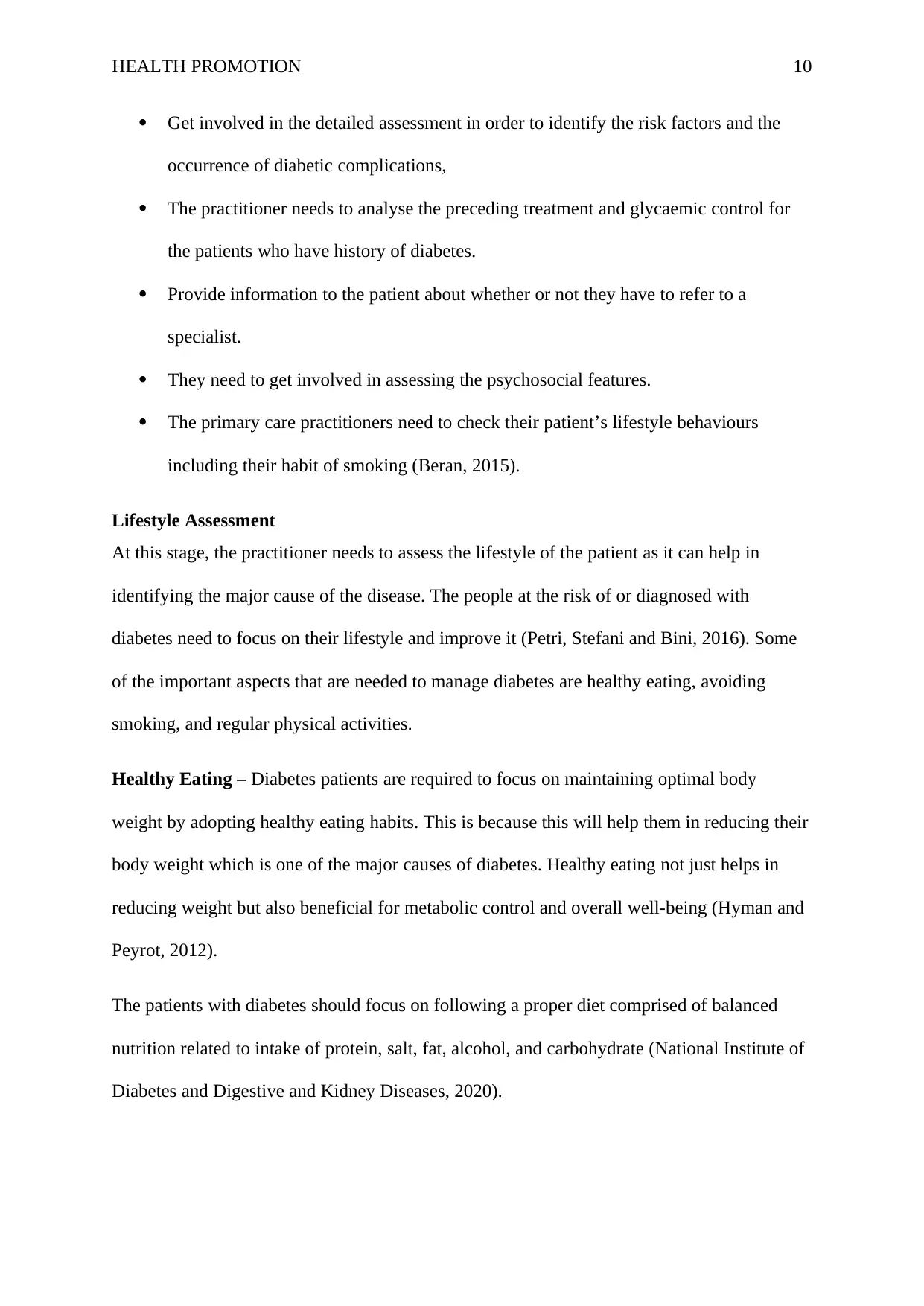
HEALTH PROMOTION 10
Get involved in the detailed assessment in order to identify the risk factors and the
occurrence of diabetic complications,
The practitioner needs to analyse the preceding treatment and glycaemic control for
the patients who have history of diabetes.
Provide information to the patient about whether or not they have to refer to a
specialist.
They need to get involved in assessing the psychosocial features.
The primary care practitioners need to check their patient’s lifestyle behaviours
including their habit of smoking (Beran, 2015).
Lifestyle Assessment
At this stage, the practitioner needs to assess the lifestyle of the patient as it can help in
identifying the major cause of the disease. The people at the risk of or diagnosed with
diabetes need to focus on their lifestyle and improve it (Petri, Stefani and Bini, 2016). Some
of the important aspects that are needed to manage diabetes are healthy eating, avoiding
smoking, and regular physical activities.
Healthy Eating – Diabetes patients are required to focus on maintaining optimal body
weight by adopting healthy eating habits. This is because this will help them in reducing their
body weight which is one of the major causes of diabetes. Healthy eating not just helps in
reducing weight but also beneficial for metabolic control and overall well-being (Hyman and
Peyrot, 2012).
The patients with diabetes should focus on following a proper diet comprised of balanced
nutrition related to intake of protein, salt, fat, alcohol, and carbohydrate (National Institute of
Diabetes and Digestive and Kidney Diseases, 2020).
Get involved in the detailed assessment in order to identify the risk factors and the
occurrence of diabetic complications,
The practitioner needs to analyse the preceding treatment and glycaemic control for
the patients who have history of diabetes.
Provide information to the patient about whether or not they have to refer to a
specialist.
They need to get involved in assessing the psychosocial features.
The primary care practitioners need to check their patient’s lifestyle behaviours
including their habit of smoking (Beran, 2015).
Lifestyle Assessment
At this stage, the practitioner needs to assess the lifestyle of the patient as it can help in
identifying the major cause of the disease. The people at the risk of or diagnosed with
diabetes need to focus on their lifestyle and improve it (Petri, Stefani and Bini, 2016). Some
of the important aspects that are needed to manage diabetes are healthy eating, avoiding
smoking, and regular physical activities.
Healthy Eating – Diabetes patients are required to focus on maintaining optimal body
weight by adopting healthy eating habits. This is because this will help them in reducing their
body weight which is one of the major causes of diabetes. Healthy eating not just helps in
reducing weight but also beneficial for metabolic control and overall well-being (Hyman and
Peyrot, 2012).
The patients with diabetes should focus on following a proper diet comprised of balanced
nutrition related to intake of protein, salt, fat, alcohol, and carbohydrate (National Institute of
Diabetes and Digestive and Kidney Diseases, 2020).
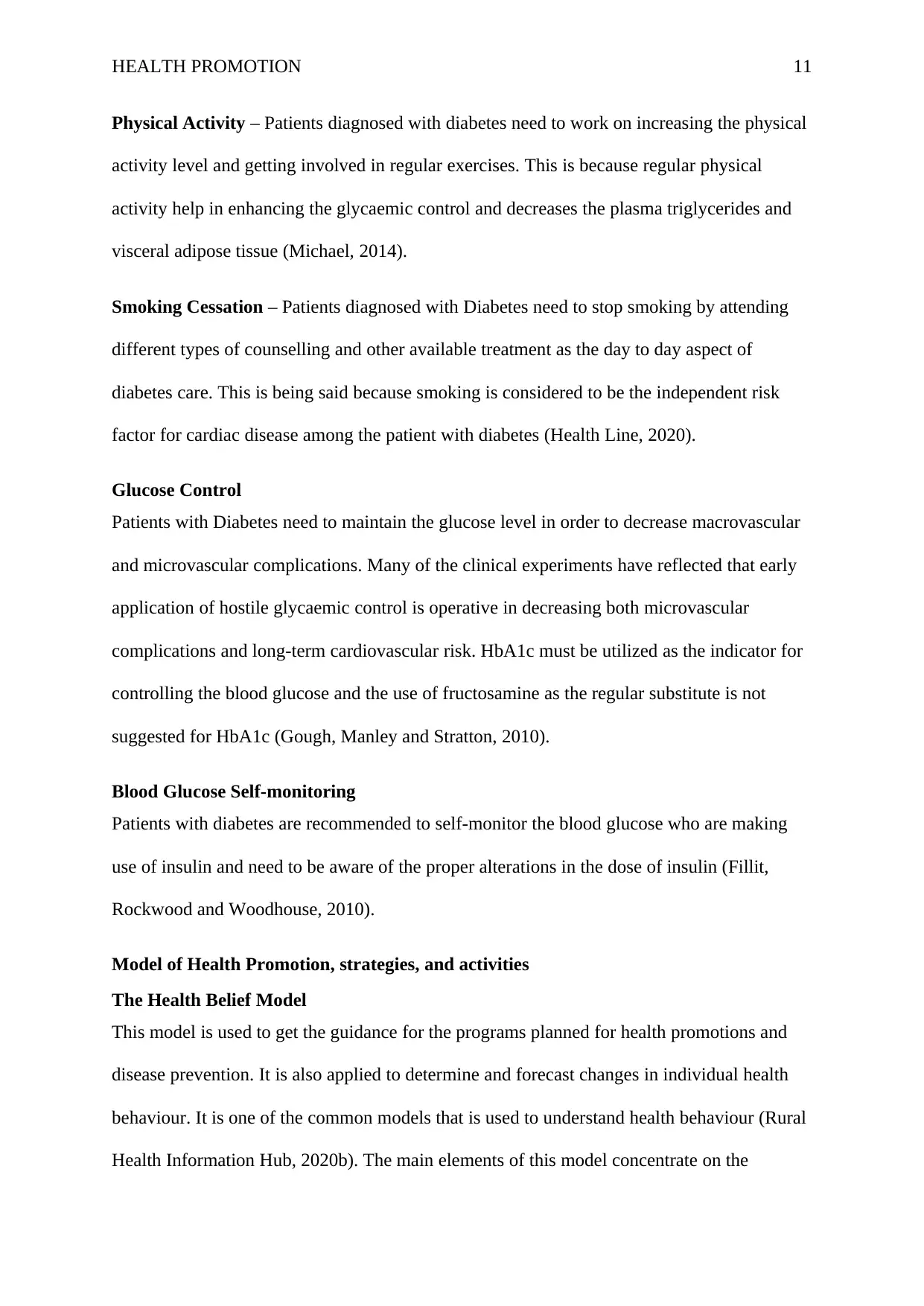
HEALTH PROMOTION 11
Physical Activity – Patients diagnosed with diabetes need to work on increasing the physical
activity level and getting involved in regular exercises. This is because regular physical
activity help in enhancing the glycaemic control and decreases the plasma triglycerides and
visceral adipose tissue (Michael, 2014).
Smoking Cessation – Patients diagnosed with Diabetes need to stop smoking by attending
different types of counselling and other available treatment as the day to day aspect of
diabetes care. This is being said because smoking is considered to be the independent risk
factor for cardiac disease among the patient with diabetes (Health Line, 2020).
Glucose Control
Patients with Diabetes need to maintain the glucose level in order to decrease macrovascular
and microvascular complications. Many of the clinical experiments have reflected that early
application of hostile glycaemic control is operative in decreasing both microvascular
complications and long-term cardiovascular risk. HbA1c must be utilized as the indicator for
controlling the blood glucose and the use of fructosamine as the regular substitute is not
suggested for HbA1c (Gough, Manley and Stratton, 2010).
Blood Glucose Self-monitoring
Patients with diabetes are recommended to self-monitor the blood glucose who are making
use of insulin and need to be aware of the proper alterations in the dose of insulin (Fillit,
Rockwood and Woodhouse, 2010).
Model of Health Promotion, strategies, and activities
The Health Belief Model
This model is used to get the guidance for the programs planned for health promotions and
disease prevention. It is also applied to determine and forecast changes in individual health
behaviour. It is one of the common models that is used to understand health behaviour (Rural
Health Information Hub, 2020b). The main elements of this model concentrate on the
Physical Activity – Patients diagnosed with diabetes need to work on increasing the physical
activity level and getting involved in regular exercises. This is because regular physical
activity help in enhancing the glycaemic control and decreases the plasma triglycerides and
visceral adipose tissue (Michael, 2014).
Smoking Cessation – Patients diagnosed with Diabetes need to stop smoking by attending
different types of counselling and other available treatment as the day to day aspect of
diabetes care. This is being said because smoking is considered to be the independent risk
factor for cardiac disease among the patient with diabetes (Health Line, 2020).
Glucose Control
Patients with Diabetes need to maintain the glucose level in order to decrease macrovascular
and microvascular complications. Many of the clinical experiments have reflected that early
application of hostile glycaemic control is operative in decreasing both microvascular
complications and long-term cardiovascular risk. HbA1c must be utilized as the indicator for
controlling the blood glucose and the use of fructosamine as the regular substitute is not
suggested for HbA1c (Gough, Manley and Stratton, 2010).
Blood Glucose Self-monitoring
Patients with diabetes are recommended to self-monitor the blood glucose who are making
use of insulin and need to be aware of the proper alterations in the dose of insulin (Fillit,
Rockwood and Woodhouse, 2010).
Model of Health Promotion, strategies, and activities
The Health Belief Model
This model is used to get the guidance for the programs planned for health promotions and
disease prevention. It is also applied to determine and forecast changes in individual health
behaviour. It is one of the common models that is used to understand health behaviour (Rural
Health Information Hub, 2020b). The main elements of this model concentrate on the
⊘ This is a preview!⊘
Do you want full access?
Subscribe today to unlock all pages.

Trusted by 1+ million students worldwide
1 out of 22
Related Documents
Your All-in-One AI-Powered Toolkit for Academic Success.
+13062052269
info@desklib.com
Available 24*7 on WhatsApp / Email
![[object Object]](/_next/static/media/star-bottom.7253800d.svg)
Unlock your academic potential
Copyright © 2020–2025 A2Z Services. All Rights Reserved. Developed and managed by ZUCOL.





